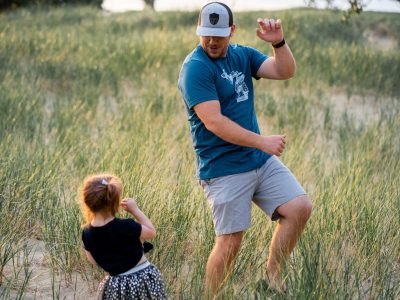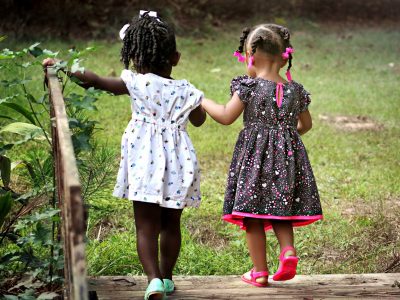
Nov 09 2021 Mindful Walking with Kids and Teens
I never learned about mindful walking as a kid, but one of my favorite childhood memories is the walks I took as an Audobon Society camper, following our counselors’ instructions to make no sound and leave no trace. Here are six mindful walking practices you can follow on walks with your grandchild of any age.
![]() Educators, click HERE for a guide to using this experience in intergenerational programs.
Educators, click HERE for a guide to using this experience in intergenerational programs.
1. Silent Walking
Walk as silently and softly as possible, leaving no trace of your presence. When you deliberately walk as quietly as possible, you are marshalling all of your attention to the act of walking, aware of the sounds and sensations in your muscles and the soles of your feet. When you walk with your young grandchild, pretend that you are biblical spies, scouts, Ninjas, trackers, or someone else who has to move in absolute silence, leaving no trail behind them, and watch how attention and awareness shift right into the present.
2. Silly Walking
With your grandchild, watch the Monty Python sketch “Ministry of Silly Walks.” Walk at first like yourself, then turn up the silliness to level one, then five, all the way up to ten, before easing back down again. The more ridiculous your walk, the more you have to focus on it not to fall over—and the more your self-consciousness and ego fall away as you give yourself over to this totally goofy practice. Exploring the contrasts between silliness and seriousness helps kids strengthen their skills of self-regulation, body awareness, and control.

3. Walk As If…
Walking as if you are different characters or with different emotions can inspire new awareness, empathy, and compassion. Try the suggestions below, or write these and more on popsicle sticks or cards, have kids pick them out, and switch every so often.
Walk as if you are:
- A sugar-addled five-year-old
- A heartbroken teenager
- The lottery winner
- Heading to see an old friend
- On a losing team
- In a big hurry
- Going into a math test you haven’t studied for
- Carrying the Torah
- A matzah ball getting up the courage to leap into the chicken soup
- An Israelite slave carrying heavy bricks for Pharaoh
- Yourself!

I always love adding “walk like yourself” into this practice because it helps boost awareness of your body in different emotional states. Kids often say that when they walked like they were sad, they didn’t see as much, or when they were in a hurry, they cared less about other people. These can be powerful insights.
4. Appreciative Walking
This mindfulness practice doesn’t require moving in a particular way, just noticing beauty in the world around you. Look for life growing in the midst of the city or concentrate on changes you see in the weather or seasons.
There are a host of blessings we can recite for appreciating nature: seeing a tree blossom for the first time in a year; smelling fragrant herbs, flowers, or fruit; hearing and seeing thunder and lightning; seeing a rainbow; seeing the ocean. Not only can you appreciate nature as you walk with your grandchild; you can say thank you or recite a blessing for all of nature’s gifts.

5. Balancing Acts
Walking is fundamentally about listening to and balancing your body. Watch a baby learn to walk and you can see how much deliberate attention goes to just standing up without toppling over. Have fun with the practices below; you can even introduce a little competition into your walk:
- Walk a tightrope, real or imaginary
- Pretend you are walking over thin ice
- Balance an egg on a spoon and walk
- Try to balance something on your head as you walk
- Walk with a dreidel (on its side) or action figures balanced on the toes of your shoes

6. Classic Mindful Walking
Sometimes the simplicity of the instruction “when you are walking, know that you are walking” is the best advice that even the youngest child can understand and appreciate. For mindfulness practice, often the simplest instruction is the best.
Walk in the ways of God (Deut. 11:22), treating the land you pass through and the people you walk past with derech eretz—respect and kindness.
Dr. Christopher Willard is a psychologist and educational consultant based in Boston, specializing in mindfulness for adolescents and young adults. He has been practicing meditation for over fifteen years, and currently serves on the board of directors at the Institute for Meditation and Psychotherapy and the Mindfulness in Education Network. He has published five books on contemplative practice and is the coauthor of The Breathing Book with Olivia Weisser. Chris teaches at Harvard Medical School. http://drchristopherwillard.com/
Jewish content provided by Judy Sandman. Judy is a writer, editor, and Hebrew school teacher. She is Bubbie to three delicious grandchildren, ages 1 to 3, and a volunteer puppy raiser for the Seeing Eye in Morristown, NJ.




 We use technologies like cookies to remember your preferences. Consenting to these technologies will provide you with a better browsing experience. JGN never shares information about your use of our website.
We use technologies like cookies to remember your preferences. Consenting to these technologies will provide you with a better browsing experience. JGN never shares information about your use of our website.